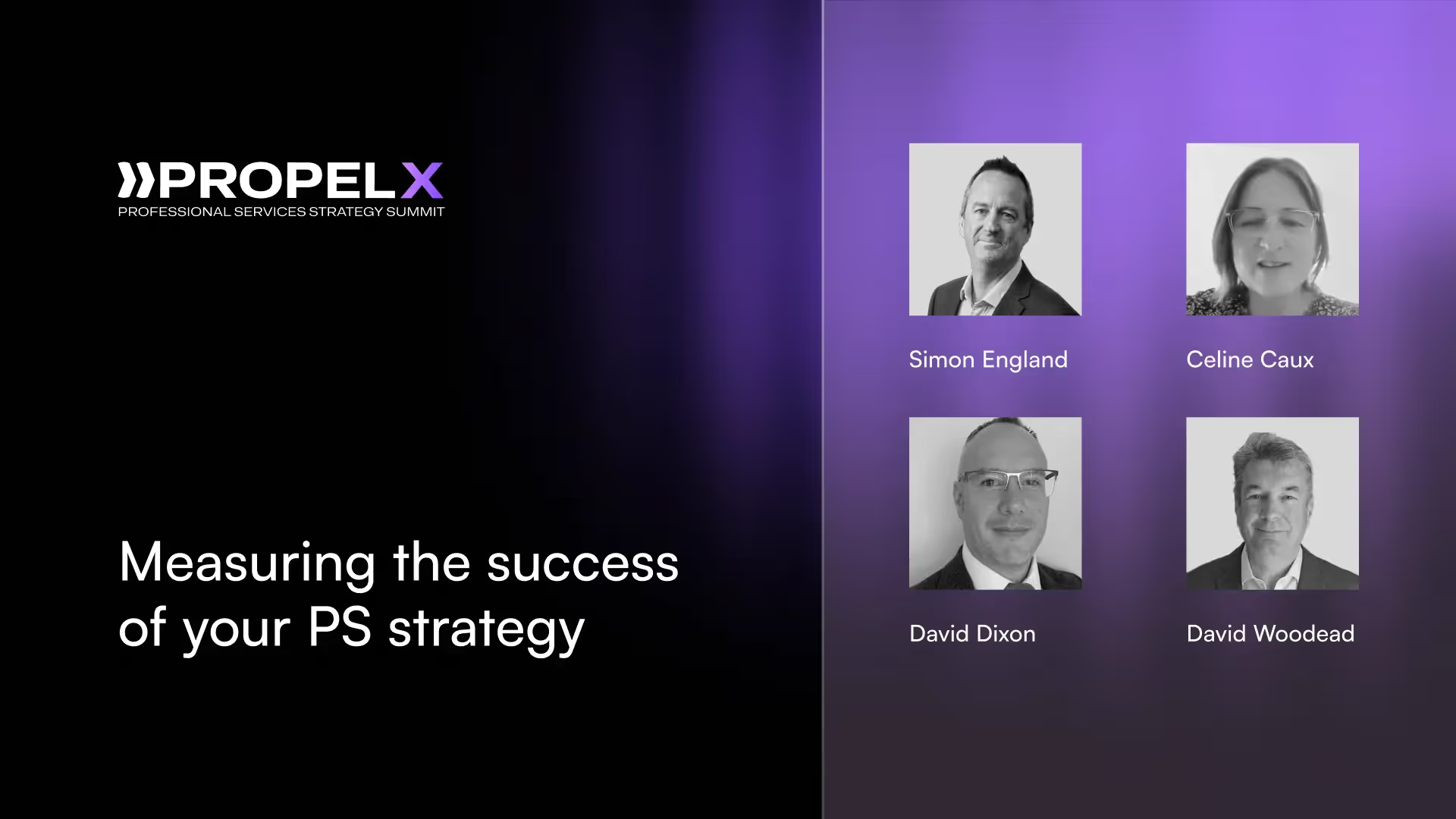A strong professional services (PS) strategy is essential for organizations that aim to optimize their operations while driving both customer satisfaction and long-term profitability.
In high-growth businesses, the need for a robust strategy has never been more critical. Companies face a delicate balancing act—managing the tension between scaling standardized services for efficiency and delivering highly customized solutions for large, complex projects.
Navigating these challenges successfully requires a strategic approach that aligns PS with the broader business goals, optimizes resource management, and ensures the right performance metrics are in place.
At PropelX, a distinguished panel of industry leaders—Simon England (Partner at Garwood Solutions), Céline Caux (Director, Transformation PMO, GoCardless), David Dixon (Vice President, Global PS, ABBYY), and David Woodhead (Manager and business consultant) —discussed various steps to build a winning PS strategy for organizations. Here are some of the key takeaways from the session.
Aligning strategy with business objectives
The foundation of any successful PS strategy lies in its alignment with the company’s overall business goals. Whether the company’s aim is rapid scaling, customer growth, or operational excellence, the PS strategy should be tailored to reinforce these broader objectives.
For businesses looking to scale quickly, standardized services can provide the framework to support that growth. Standardization allows for repeatable processes, which are essential when delivering services at scale across a broad customer base. In sectors like mid-market where consistency, predictability, and efficiency are valued, standardized packages can be a highly effective way to meet client needs while managing costs.
However, a one-size-fits-all approach won’t always work, especially when dealing with large enterprise clients. For complex projects, clients often need highly customized solutions that go beyond what standardized services can offer. This is where many companies face strategic tension—how do you balance the need for efficiency with the demand for bespoke solutions?
To resolve this tension, it’s important to assess the strategic mix of standardized versus custom services. A deep understanding of the company’s revenue composition is key here. If large, high-value deals make up a significant portion of the business, it may make sense to invest more in custom service capabilities. On the other hand, if the business is focused on volume and scaling, standardization will take precedence. Understanding this balance ensures that the PS strategy is both aligned with long-term goals and adaptable to changing customer needs.
Leveraging standardized services as a foundation
While custom solutions are essential for high-value clients, standardized services can serve as a strong foundation, even for larger projects. The key is to approach standardized offerings not as rigid, inflexible products but as building blocks that can be adapted to meet more complex needs.
For mid-market clients, standardized services provide a quick and efficient way to deliver value. These packages can be implemented more swiftly, offering a predictable experience that meets common needs with minimal customization. However, for larger enterprise clients, standardized services can act as the starting point for more complex projects, accelerating the overall delivery process.
Instead of starting from scratch with each new engagement, companies can use these standardized offerings as a base, layering custom elements on top as needed. This hybrid approach allows for the efficiency of standardized services while also offering the flexibility to tailor solutions for more complex requirements. This not only saves time but also minimizes costs and ensures faster time-to-value for clients. In essence, standardized services become a springboard for delivering custom solutions more effectively.
Rethinking success metrics
Traditional performance metrics like utilization—often defined as the percentage of billable hours a PS team works—have long been used as a key measure of success. While utilization remains important for tracking the efficiency of service delivery, it’s not always the best measure, especially for large, custom projects that don’t fit neatly into the billable hours model.
Instead, it’s essential to rethink success metrics and align them more closely with both customer outcomes and business goals. Focusing solely on utilization can lead to inefficiencies and misplaced priorities, where teams are incentivized to maximize billable hours rather than deliver value. A broader set of KPIs, such as improvements in working capital, invoicing efficiency, customer satisfaction, and project outcomes, can provide a more holistic view of success.
For instance, some organizations have found significant benefits in shifting their focus from utilization to financial and operational KPIs. Tracking metrics such as working capital improvement, quicker invoicing cycles, or customer retention rates provides a clearer picture of the business. Expanding the scope of metrics to include both financial and operational outcomes helps companies ensure that their PS teams are aligned with the long-term business objectives.
Some organizations also use sentiment analysis and simple capacity checks to gauge the well-being and workload of their PS teams. A shift toward qualitative metrics like employee satisfaction and project-level sentiment can help ensure that teams remain engaged and productive, further enhancing overall service delivery.
Streamlining resource management for scalability
A key component of a successful PS strategy is resource management. As companies grow and scale their PS operations, resource allocation becomes increasingly complex, particularly when managing the demands of both standardized services and large custom projects.
One common challenge is the siloing of resources within different verticals or customer segments. While it might make sense to assign specialized teams to certain industries or sectors, this can lead to inefficiencies over time. Specialized teams may become overstaffed or underutilized depending on demand, making it difficult to respond to new opportunities in a flexible manner.
To overcome this challenge, organizations can centralize key roles, such as project managers, solution architects, or other specialized resources. Creating a flexible, centralized resource pool allows companies to deploy talent where it’s needed most, rather than locking resources into a specific vertical or segment.
This approach not only optimizes resource allocation but also ensures that high-value projects are adequately staffed while maintaining the efficiency required to deliver standardized services at scale. Centralized resource management allows for greater agility, ensuring that companies can respond quickly to client needs without sacrificing operational efficiency.
Adapting commercial models to changing market demands
A successful PS strategy requires flexibility, particularly when it comes to the commercial model. As market dynamics evolve, so must the way organizations price and deliver their services. Companies that are bold in experimenting with new commercial approaches often find greater success in adapting to client demands.
One area of innovation is the adoption of outcome-based pricing models. Instead of charging based on time and materials or fixed fees, some companies are exploring models that tie service fees to specific outcomes, such as customer success or implementation efficiency. This approach aligns the interests of both the client and the service provider, ensuring that both parties are focused on delivering measurable results.
Moreover, bundling PS with other functions—such as customer support or success—can create a more comprehensive offering that delivers greater value to clients. For instance, some companies offer ‘PS packages’ that combine implementation services with ongoing support and success management, ensuring clients receive continuous value throughout the lifecycle of the service.
Adapting the commercial model to include both standardized and outcome-based pricing allows companies to better align their offerings with client expectations, driving both profitability and long-term growth. Flexibility in pricing and service delivery ensures that companies can meet the diverse needs of their client base while maintaining operational efficiency.

























.webp)